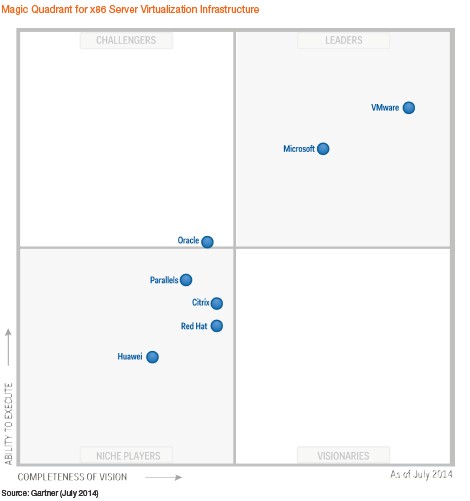VMware, Microsoft Rule X86 Server Virtualization

In many ways, the choice of a server virtualization technology is more important for a large enterprise than is the choice of the underlying physical server platform. While the X86 platforms that dominate enterprise datacenters are not perfectly uniform and do offer some differentiation, a server acquisition is as much a political one (usually playing vendors off against each other) as a technical one. With server virtualization, there are a number of different and incompatible technologies, and you have to live with that decision for many years to come.
People like easily digested information, even for extremely technical decisions, and that is why the Magic Quadrants put together by the analysts at Gartner are so popular. You can take in the competitive landscape in one simple image and then drill down into the details. Gartner has just released this year's X86 server virtualization rankings and the competitive landscape has changed a bit among the commercially supported options, but VMware and Microsoft are still dominating this market as they compete fiercely against each other and various open source alternatives.
You can dice and slice the hardware in a physical server using a number of technologies, but the key two are based on a hypervisor that chops up the system into virtual machines that in turn run their own (and often incompatible) operating systems atop the hypervisor or containers (sometimes called zones or virtual private servers) that have application sandboxes running atop a shared operating system kernel and file system.
The Gartner Magic Quadrant rankings take both approaches into account as well as basic server virtualization management frameworks and capabilities such as live migration of running workloads. The comparisons are only made for X86 platforms and ignore some of the very sophisticated options available on mainframe, RISC, or Itanium platforms, mainly because these are no longer volume products and because the virtualization functionality for X86 systems has matured and is on par with non-X86 alternatives. The Gartner Magic Quadrant rankings only examine the commercially supported versions of hypervisors, whether they are closed or open source, and ignore the open source options that are available. The comparisons also ignore the virtual desktop broker and cloud controller extensions to these server virtualization tools, even though VDI and cloud are two major drivers for server virtualization. The idea is to restrict the comparison to the server virtualization layer in the hardware-software stack and to those tools that have the vendor-backed development and technical support that large enterprises tend to require. The hyperscale datacenter giants that weave their own variants of Linux, hypervisors, cloud controllers, and system management tools do not count as far as this Magic Quadrant ranking is concerned.
VMware continues to have market share and mind share lead among enterprises with its ESXi hypervisor and vSphere and vCenter management tools, but Microsoft has been gaining ground in recent years with its Hyper-V hypervisor and System Center console. But with an estimated 70 percent of X86 workloads already virtualized in the enterprise datacenter, according to Gartner, VMware is having a tougher time growing this server virtualization business and is seeing competition from Hyper-V and KVM, the latter being an open source hypervisor that is steered by Red Hat, Canonical, IBM, and a few other interested parties that want an alternative to the open source Xen hypervisor that is used on the Amazon Web Services, Rackspace, and SoftLayer public clouds (just to name three big ones).
In a poll that Gartner did back in December, more than 90 percent of customers said that VMware was their primary server virtualization hypervisor, but 48 percent said they were also using Hyper-V as their secondary hypervisor for X86 machines. VMware has the dominant share of existing workloads, but Gartner's analysts say that for new workloads that are being virtualized, VMware's share is much smaller. The reason is simple: Microsoft is competing on price. Once you have to buy Windows Server Datacenter Edition to run on your servers, you have unlimited virtualization using Hyper-V built into the price. If you are supporting Windows workloads, you can save a lot of money on Hyper-V if you can do the application conversion and if Hyper-V has the features you need.
Having said all that, VMware is positioned above as well as any vendor could be in its market – it is the leader in terms of its vision and its ability to execute – and the Gartner Magic Quadrant reflects that:
All of the other companies selling commercial-grade server virtualization tools for X86 iron are niche players. Citrix Systems use to be able to get itself barely into the upper right quadrant but has slipped down into the lower left. Oracle, with its homegrown variant of the Xen hypervisor called Oracle VM and the container technology available in its Solaris variant of Unix, is the only challenger as far as Gartner is concerned.
As the Docker container technology for Linux begins to take hold and gets the requisite minimum of 100 commercial customers that it takes to be placed on the Magic Quadrant, you can expect Docker to make it into the rankings. Perhaps in 2015.
This year, the new entrant is Chinese IT giant Huawei Technologies, which cooked up its own variant of the Xen hypervisor back in 2011 and which has been selling it along with its systems in its home country as well as in Brazil, Russia, India, and other high-growth markets where it has customers. The FusionSphere hypervisor can have up to 512 VMs on a host server and up to 3,000 VMs in a host cluster. By aggregating clusters, the Huawei setup can span up to 80,000 VMs under one management framework. The Xen implementation can span 160 cores and 2 TB of memory in a physical server, which is good enough to compete with ESXi, Hyper-V, and KVM. Incidentally, Huawei is working on a variant of FusionSphere that is based on the KVM hypervisor so its customers will not be relegated to Xen only, and it would not be at all surprising for Huawei to adopt Linux containers (LXC) or Docker containers (which does more than LXC) as part of the FusionSphere stack.
Citrix Systems has breathed some life back into the XenServer commercial variant of Xen, particularly by completely opening up all parts of the XenServer 6.2 stack last summer. But a number of important System Center interoperability features that were part of XenServer as well as others that allowed Citrix to compete head-to-head with offerings from Microsoft and VMware have been deprecated. Citrix is now more interested in tuning up XenServer to better support CloudPlatform, the commercial-grade version of the CloudStack cloud controller, and getting it to be the preferred hypervisor for its own XenDesktop desktop virtualization tools. XenServer has the virtue of being free to license, but customers do have to pay for support contracts.
Parallels is interesting in that it offers server virtualization in the form of both containers and a hypervisor with its two products, Parallels Containers and Parallels Server Bare Metal, that can support either Windows or Linux instances. This is one of the reasons why the Parallels tools continue to be popular with service providers.
Red Hat is making progress in the commercialization of KVM, but it has yet to break into the upper right quadrant. Red Hat cannot take on VMware directly, but has aligned KVM with the OpenStack cloud controller and its own middleware and management tools and will likely see strong adoption of KVM in greenfield cloud installations. The large installed base of Red Hat Enterprise Linux should also push adoption of KVM, but a lot of RHEL workloads run in bare metal mode. Garner estimates that somewhere between 70 to 75 percent of all Windows workloads have been virtualized, but only about 45 percent of Linux workloads have been. Some companies that have avoided hypervisors because of the overhead penalty will be more inclined to bare metal or look to tools such as LXC or Docker containers that have much lower performance overhead and lower cost compared to a full-on hypervisor like Red Hat Enterprise Virtualization.











